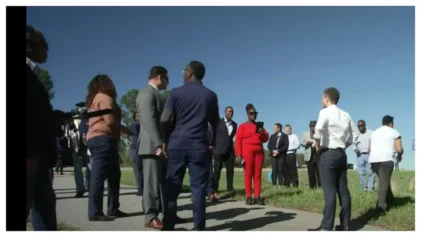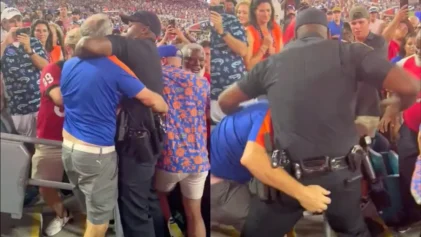In Malden, Mass., the long-simmering argument of how appropriate it is for African-American women to style their hair as they choose hit a new crescendo. In an attempt to, as the Mystic Valley Regional Charter School interim director said, “… promotes equity by focusing on what unites and by reducing visible gaps between those of different means,” the school placed a restriction on hair thickness and extensions that seemed to directly contradict U.S. Department of Justice guidelines on race-based policies.
This policy and its uneven enforcement — the school rarely, for example, punishes students for hair color, another dress-code violation — led to the repeat suspensions of African-American female students. Singled out were Mya and Deanna Cook, who have received more than 16 hours’ detention, were removed from their team sports and banned from their proms — all for having braided hair. This has, since the breaking of this story, led to a letter of condemnation from the state’s Attorney General Office, a lawsuit from the ACLU and the school district suspending the controversial policy.
“The policy specifically prohibits ‘shaved lines or shaved sides’ as examples of drastic or unnatural hairstyles, and ‘hair more than 2 inches in thickness or ‘height’’ as an example of hair that is distracting and thus not allowed,” Genevieve Nadeau, the chief of the Massachusetts Attorney General’s Division of Civil Rights, wrote.
“These prohibitions appear to specifically reference hairstyles such as ‘fades’ that are commonly worn by Black male students, and ‘afros’ that are most likely to be worn by Black students (both male and female). These styles are not simply fashion choices or trends, but, in addition to occurring naturally in many cases, can be important expressions of racial culture, heritage, and identity.”
Cases such as the one in Mystic Valley seem to go beyond cultural insensitivity and constitute an implicit attack on African-American females’ right to be who they are. A 16-year-old Black student in Montverde, Fla., who happens to have naturally curly hair, was told recently that her hair was a violation of the school’s “no dreadlock” dress-code policy. In 2013, a 12-year-old in Orlando, Fla., was told to either straighten or cut her puffy hair or face expulsion. The student, at the time, was being subjected to bullying by her classmates for her hair.
As profiled by the Kirwan Institute for the Study of Race and Ethnicity at the Ohio State University, African-American students are more likely to be removed from instruction than their white counterparts for minor infractions such as dress code violations due to implicit bias. In one cited example, Black students in North Carolina public schools were six times more likely to be suspended than white students for dress-code violations. These offenses are, in less-served schools, typically handed over to the police to handle.
This prosecution of Black hair amounts to the criminalization of being African-American. Attacking one class for what would be acceptable with another constitutes not just a mentality that seems to persist and proliferate through miseducation and lack of positive exposure but also an open-ended attack on what it means to be oneself.
“These attacks leave a very dangerous and destructive message,” Carlota Zimmerman, a career and lifestyle coach, said. “To be told by your teachers, adults, by your society that your hair, as it is naturally, is ‘wrong,’ or ‘inappropriate’ for school, that you should change yourself to be deemed worthy to get an education, to get opportunities? We’re sending a terrible message to our Black youths that as they are is wrong. As they are is not fit to be educated, to be valued, to contribute. This message destroys lives since our lives are based on our self-confidence, on our sense of self, our sense of value.”
Black Hair Discrimination
In order to understand this controversy, a few points must be made clear. To start, most women have a natural hair state. Unless descended from specific Native American, Asiatic and Western European ethnicities, most women’s hair — when left to its own volition — will take on a curly, fizzy, wavy or otherwise voluminous state. The 2012 Disney movie “Brave,” for example, took a good deal of flak on social media for showing a Scottish “Disney Princess” with a full mane of frizzy red hair.
Women’s hair care is a multi-billion-dollar global industry. The daily maintenance and personal expense needed to keep hair at a publicly acceptable level are one of the greatest headaches women deal with as part of their daily routine.
“There’s no such thing as ‘wake up and go,’” an uncredited Black woman is reported saying, per Kovie Biakolo. “Whether I wear my hair naturally, curly or straightened via flatiron, making it presentable is a process. When it’s curly, it gets dry very quickly and goes flat after a day or two. I have to re-wet, moisturize, comb and brush almost every day to keep the curls looking healthy and full. When it’s straight, I have to touch up my hair with a flatiron even to wear it in a ponytail. That’s not to mention the process of straightening it in the first place, which is nearly two hours of washing, blow drying and straightening.
“This upkeep doesn’t sound like much, but all this work brings my hair nothing close to white standards of beauty,” she continued. “I fight with and destroy my hair to get it to look as close as possible to a standard I know it will never achieve because it’s just not in its nature. But what’s the alternative?”
While hair struggles are a natural part of being a woman, rarely does this warrant more than odd looks outside the Black experience. While non-conforming hairstyles might be brushed aside as a fashion faux pas or a non-event if done by a non-Black woman, when Black women wear hairstyles that don’t conform to “white standards,” it can lead to job terminations, school suspensions and even arrests.
Take, for example, 2014. On March 31 of that year, the Army announced that it has updated its appearance and grooming policy. The policy, known as AR 670-1, banned cornrows, braids, twists and dreadlocks, arguing that these hairstyles interfere with the fitting of essential equipment, such as combat helmets. This turned out to be ironic, as most of the women affected by this policy chose these hairstyles to reduce the maintenance time needed and to be more “combat-ready.” The policy was overturned shortly thereafter.
Since the inception of the country, Black hair has been linked to negative stereotypes about being African-American. “Hair type rapidly became the real symbolic badge of slavery, although, like many powerful symbols, it was disguised, in this case by the linguistic device of using the term ‘Black,’ which nominally threw the emphasis to color,” Harvard sociologist Orlando Patterson wrote in his book “Slavery and Social Death.” “No one who has grown up in a multiracial society, however, is unaware of the fact that hair difference is what carries the real symbolic potency.”
“These attacks on Afrocentric styles and fashions are unfortunately definitely not new. I was speaking to a Black female friend who, in the 1960s, did some modeling with the likes of Richard Roundtree of ‘Shaft’ fame, and she was telling me stories that were interchangeable from today,” Zimmerman added. “Racism has all the time in the world. I think the difference is nowadays with social media, these attacks are getting far more attention, and also due to social media, more people of color are finding comfort and strength in accepting themselves as they are. So, there’s less tolerance and much more public anger.
“When you factor in our first Black president, police shootings of Black men, I think many people of color see these attacks upon women’s hair similar to physical assault.”
The Bias against Natural Hair
In 2016, the Perception Institute conducted an online study into how perceptions of African-American women are influenced by explicit and implicit biases toward their hair. The study was inspired in part by SheaMoisture’s 2016 “Break the Walls” campaign, which challenged retailers’ traditional position of separating hair products by race, with nonwhite products being delegated to the “ethnic” section. By segregating products meant for women of color, there may be a subliminal message that ethnic hair is somehow different from “normal hair.”
To test this, the Perception Institute tested users for implicit and explicit biases by showing photos of a single model wearing both straight and “natural” wigs and asking what words and phrases come to mind when they see the photos.
- Black women that consider themselves naturalistas are the most positive about textured or natural hair, seeing it as “beautiful,” “sexy” and “professional” at a greater amount than any other population, including other Black women;
- Black women remain sensitive of social stigma surrounding textured hair;
- Millennials are more accepting of natural hair than any other women in the sample;
- Black women are more anxious about their hair than White women;
- Ruining their hair is the excuse for a third of all surveyed Black women skipping exercise;
- Twice the number of Black women feel pressured to straighten their hair for work than white women;
- Black women invest more time-wise and in actual expense in their hair than white women; and
- White women are more likely to be explicitly biased against Black hair compared to “smooth” hair, finding it to be “less attractive,” “less beautiful’ and “less professional.”
“It is curious that the study found millennials to be the most accommodating to textured hair,” Alexis McGill Johnson, the executive director of the Perception Institute, said. “This is significant because even if most of us would say that an afro is beautiful to a survey, we’ve taken in so many social cues about hair that it is hard to escape media about it. These millennials have been involved in online communities, replacing the cultural knowledge we have lost in the decades we have been straightening our hair and creating reaffirming images that helped replace the negative schemas.”

The road toward breaking down the implicit biases against natural hair starts with a reflection of one’s personal bias. (Courtesy: Pixabay/cherylholt)
The Enemy in the Mirror
The bottom line with hair bias is that, for many, it is veiled racism. Textured hair reminds the prejudiced viewer of Black culture and draws an unthinking reaction. There may be no convenient solution to implicit racism except to expose it at every opportunity.
There is another component to hair bias, however, which could be combatted. To illustrate this, let us take, for example, the former first lady Michelle Obama. When she entered the White House, she had heavily processed “smooth” hair. To the casual viewer, she met the visual expectation of a successful, professional Black woman — well coifed, well dressed and well spoken. When, while on vacation, she allowed her hair to go natural, the criticism she received, despite changing nothing else of her public persona, was severe.
This is even more shocking in retrospect considering she has been seen wearing her hair naturally more often, to the Internet’s acclaim, since leaving the White House.
Since the time of slavery, natural, “nappy” hair was seen as being more undesirable than hair that mirrors Eurocentric styles. Unprocessed, non-straight hair suggested the person was uncivilized, uneducated or somehow dangerous. To be accepted, African-American women (and men) not only subjected themselves to hot combs, lye-based hair treatments and a host of other hazardous treatments, but they also taught their daughters to do the same. This is reflected in the oft-repeated unwritten rule, “Straighten your hair for the interview, wear it natural once you are through the door.”
This notion that success and beauty are connected to straight hair still proliferates in the media. Many of the role models for African-American women have chemically processed straight hair because it is what they were told was needed to be taken seriously. Entire generation – both white and Black – have seen the allegedly most successful and socially acceptable among Black women wear their hair straight and formed an association between straight hair and Black success and Black beauty. This is how implicit bias is born.
As pointed out in the article Hair Story: Untangling the Roots of Black Hair in America, various African tribes adapted elaborate hair braiding patterns as a messaging and identification schema as early as the 15th century. One of the ways slavers would break newly captured enslaved women of their identities was to shave their heads.


